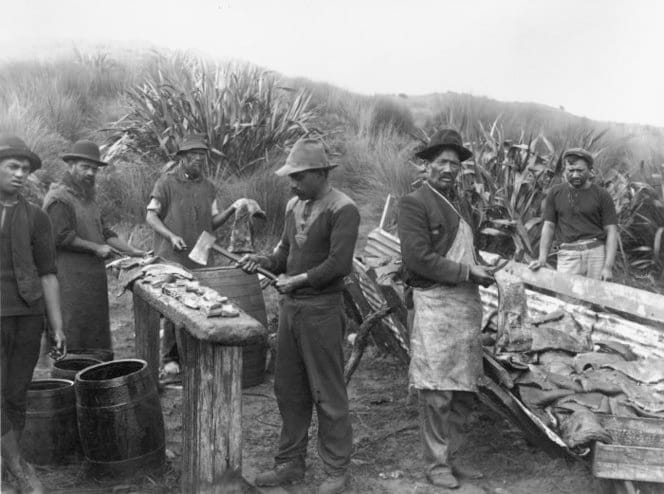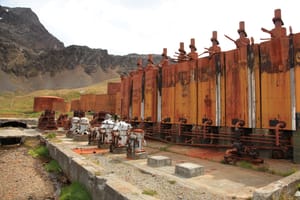I ate whale for the first and only time almost 20 years ago, in Singapore. This was at a place called Kazu, a perpetually smoky sumiyaki (literally “charcoal grilled”) joint in a one-building Japantown, a dilapidated mall whose upper levels were a motley of whisky/hostess bars, yakitori shokunin, two-person obanzai counters serving “grandma cooking” and sake, and a lone coffeeshop that catered to the local staff of the Japanese businesses. None of the many many eateries had an exhaust system that was actually up to the task, so the place existed in a karaoke-video haze. The building’s corridors were deserted while the businesses were packed, and some acoustical magic, or perhaps the thickness of the air, created an archival hush that reinforced the sense of timelessness. I have great affection for these vertical neighborhoods, strata-titled warrens that amplify Singapore’s urban density, the broken-off flotsam of a dozen countries lodged like unexpelled shrapnel in the city’s core.
The whale came as a nose-to-fluke assortment of sashimi, wafers rather than the slabs in which most sashimi is cut. I mostly remember the pieces of fluke (the tail) with steakhouse marbling, its blubber the color of cream. The meat was simultaneously cool, raw beef clean, and somehow deeper and more marine than lean tuna, infrared to tuna’s crimson, and it had a stiffness, not quite a crunch, that I associate more with bivalves than fish. Like crocodile or frog, it had a chimeric quality – improbable associations stitched together in each bite.
All this is by way of saying that I’m pretty sure whale oil in its most basic form (which I’ve never tried) would taste pretty distinctive. The historical record supports this: Even in a fat-scarce, pre-petroleum world, whale oil remained enough of an acquired taste that, the occasional batch of whale oil doughnuts aside, we used it mostly for lighting.
I used to associate whaling with the era of oil lamps, three-masted whalers, and hand-thrown harpoons, but most whales were actually killed after 1945, by which time we’d forgotten most of our other uses for the products of whaling – spermaceti, baleen, heaps of lean whale meat. By the time we banned commercial whaling in 1986, the leading use of whale oil was in margarine. A huge fraction of all recorded whale hunting took place basically in order to provide the world with something that felt like a luxury as it rebuilt after the war. As Seth Miller memorably put it, “mostly, the whales were spread on toast.”

The invention that catalyzed this maritime Grand Guignol was the Wesson process, which deodorizes oil using a combination of superheated steam and vacuum. Most vegetable oil today tastes and smell of very little – you’ve almost certainly seen reference to “neutral vegetable oil” in recipes. This neutrality is an entirely modern invention, the result of a battery of refining technologies, effective industrial-scale deodorization being the most recent and perhaps most important one.
The Wesson process arose from the abundance of cottonseed. By the mid-19th century, slavery had made cottonseed, a by-product of cotton production, so cheap and so abundant in the US that numerous inventors were trying to find ways to extract value from what was frankly an unpromising resource. Behind cottonseed’s tough hull lay a kernel from which you could press a rust colored, unpleasantly bitter, and mildly toxic oil with few if any applications in industry. But you couldn’t beat the price, so numerous inventors, beginning with William Fee in 1842 and ending with Wesson 50 years later, spent untold hours looking for ways to make cottonseed oil useful, laying the foundations for the modern edible oil industry in the process. As refining techniques improved, cottonseed oil became for a time the most commonly consumed vegetable oil in the US, the original base for Crisco, and a popular frying medium (for, among other things, doughnuts).
Like cottonseed oil, unrefined, cold-pressed palm oil isn’t neutral at all. It’s the color of Jessica Rabbit’s hair, with a pepperiness that people outside Africa tend to associate with olive oil, softened by an almost vanillin warmth. But refined, bleached, deodorized palm oil – which is both a description and a term of art for the commoditized form of palm oil most commonly traded – is nearly indistinguishable from refined, bleached, deodorized oil from any other source.
So it was with whale oil in the 20th century. As Miller writes, enough countries had enough invested in their whaling industries – industries that no longer served any real productive purpose – that we had to find something to do with the fruit of their slaughter. The market no longer had a use for whale oil as whale oil, a unique substance with specific, desirable properties. But this very lack of demand, combined with the advent of diesel whaling ships and explosive harpoons, made whales cheap – the cottonseed of the 20th century.
In 1952, John Kenneth Galbraith posited a “dependence effect” in modern capitalist economies, that “production only fills a void that it has itself created.” He was writing about consumer goods, and what he saw as the need to use advertising to create desire where none existed before, but it’s easy to see a sort of dependence effect in the history of whale oil, and cottonseed oil, and now palm oil too. We were producing these commodities, so we had to find a market for them, or make one. If we couldn’t engineer demand for whale oil as whale oil, a distinct substance with particular properties, we would create demand by making whale oil indistinct and cheap.
But hunger wasn’t invented by industry. We turned whales into margarine because in the middle of the 20th century, people genuinely needed something, anything, to put on toast. Global population and per capita income were exploding (however unevenly), and humanity’s collective appetite for fat exploded along with them. To paraphrase Galbraith, production only filled this void under the force of its own momentum.
SCOPE CREEP.
- I don’t know how many of the grills in the building where Kazu is were burning Binchotan, the classic yakitori charcoal, but they really should have been. Binchotan releases almost no smoke, the result of a production process that results in logs of almost pure carbon. When tapped, it sounds like porcelain, or glass.
- The bleaching in “refined, bleached, deodorized” is accomplished by blending the oil with Fuller’s earth, also known as bleaching clay or diatomaceous earth, at surprisingly high concentrations – up to 2% – then heating the oil and filtering out the precipitate.
- Before it was possible to fully deodorize cottonseed oil, it still made its way into the food chain, as an (illegal) “fortifier” for animal fats. The practice was discovered in 1884 by our old friends Armour & Co., when they “sought to corner the lard market and realized [they] had purchased more lard than the existing hog population could have produced.”
- I tried and failed to find a US military specification for frying oil, but I came across the MilSpec for brownies and oatmeal cookies, which was an internet phenomenon maybe 15 years ago. The writing veers between genius and horror – the recipe is only specified in parametric form, but some ingredients are specified in milligrams per pound.
- The Lamb Chop dog toy complex might be my favorite example of an industry creating its own market. The last episode of the children’s TV show aired in 1997, but the production line for these puppets is apparently still running, because they’re now among the cheapest and most highly rated dog toys you can find. Also, the fluffy lamb my dogs regularly dismember is apparently a 3-star general in the US Marine Corps.
Thanks as always to Scope of Work’s Members and Supporters for making this newsletter possible.
Love, tw
p.s. - If you’re in NYC or Cambridge, coffee’s on me!
p.p.s. - We care about inclusivity. Here’s what we’re doing about it.


